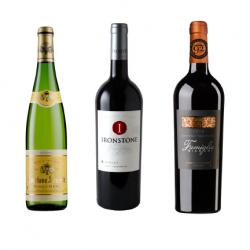Like artists with extensive color palettes, talented globally inspired chefs continue to combine ancient and modern ingredients in highly original ways to delight sophisticated food lovers.
No matter what food is served or where the ingredients or recipes originate, the right wine pairing can reveal added dimensions of flavors. A particularly fun food and wine challenge is to find and pair wines with an eclectic menu that covers many countries’ cuisines.
For those who love a great food adventure in the St. Louis area, there is the innovative Element Restaurant that serves up tradition, modernity and creativity on their menu, which includes Freekeh salad, beet and orange soup, coulotte with chimichurri, and many other diverse dishes that are enhanced when served with the right wines.
Freekeh salad is an increasingly popular roasted young wheat that cooks quickly and is high in fiber. It is an ancient whole grain from the Middle East and North Africa with a nutty and subtly smoky flavor, and one chefs can use for many types of healthy salad. Freekeh salad often bursts with vibrant flavors – everything from butternut squash to chili flakes. What wine would be food-friendly enough to pair with the many variations of Freekeh Salad?
An exceptional pairing answer lies in Alsace, France – home to some of the world’s most food-friendly white wines. Pinot Gris has been known since the Middle Ages and is a major grape in the Alsace. The word “pinot,” which comes from the word meaning “pine cone” in French, may have originally been used because the grapes grow in small pine cone-shaped clusters. The grapes’ grayish-blue color accounts for the word “gris” (the color “gray” in French). Pinot Gris is thought to be a clone of Pinot Noir, while Italy’s Pinot Grigio is a clone of Pinot Gris.
The full-bodied Pinot Gris from the Alsace is markedly different than its Italian offspring, with moderate-to-low acidity and more prominent flavors. Since 1836, a well-known name in this eastern wine region of France which borders Germany has been Gustav Lorenz, in the town of Bergheim. The dry and versatile Gustave Lorenz Pinot Gris, with its very enjoyable silkiness, balanced acidity and pleasant, fruit-forward palate is outstanding as an aperitif, or with a wide range of appetizers and salads, including those featuring Freekeh.
A truly imaginative wine pairing is required for the colorful, luscious and richly nutritious beet and orange soup. It combines the taste of beets with a range of acidic, spicy and smoky notes. California Merlots offer a winning partner to this “new world” soup. From Lodi, CA, which has served as a major grape-growing region for more than half a century, recently rediscovered for its unique micro-climates, comes Ironstone Merlot. It is brimming with luscious, dark fruit and soft tannins, raising its drinkability quotient. The softer, fleshier fruit-forward nature of this wine – which includes a touch of smoke as well as hints of vanilla and toast – makes it an excellent accompaniment to spicier dishes with smoky elements.
In a different place and time, Italian immigrant Valentin Bianchi arrived in Argentina and, in 1928, realized his dream of owning a vineyard and making his own wines. Today, in the well-known and highly respected Mendoza region of Argentina, the third generation of the Bianchi family continues to produce their popular Argentine wines with Italian roots.
With a lesser-known, juicy and more-affordable cut of steak taken from the sirloin, called the coulotte, served with a garlicky and herbaceous Argentinian chimichurri sauce, why not stay in the same country where the beef is plentiful and the red wines are ready made to take them on.
A classic Argentine red, like Bianchi’s Famiglia Bianchi Cabernet Sauvignon, competes with the best from around the world and brings out your inner gaucho! This wine displays a deep ruby color and has great legs. Aromas of black pepper, licorice, toasty coffee grinds and hints of fresh mint mingle with flavors of cassis, wild berries and cedar. This is a warm, welcoming wine that is great to serve with roasts and almost any other red meat.
There are so many tastes of the world to explore, and it is a joyous pursuit. Trying new cuisines with family and friends, and pairing the dishes with wines that truly complete the culinary picture, lead to a great dining experience. The only limit is your imagination, and a well-curated restaurant wine list or well-stocked local retailer.











